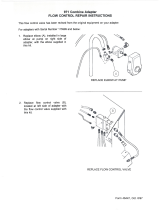
Part number 550-100-066/0608
g a s -f i r e d w a t e r b o i l e r — Boiler Manual
14
Install water piping
Use two wrenches when tightening water piping at boiler,
using one of the wrenches to prevent the boiler interior
piping from turning. Failure to support the boiler piping
connections to prevent them from turning could cause
damage to boiler components.
General piping information
Additional controls, when required
The U-Control module uses temperature sensors to
provide both high limit protection and modulating tem-
perature control. The U-Control module also provides
low water protection by sensing the temperature of the
heat exchanger. Some codes/jurisdictions may require
additional external controls for high limit and/or low
water cutoff protection.
Additional limit controls
Following standard industry practices, if installation is to comply with
ASME or Canadian requirements, an additional high temperature limit
may be needed. Consult local requirements for other codes/standards
to determine if needed.
Install a manual reset high temperature limit constructed to prevent 1.
a temperature setting above 200°F in system supply piping between
boiler and isolation valve. (Note that the U-Control module op-
erating limit function shuts the boiler down at 195°F, or lower if
set to a lower value.)
— If the heating system
includes circuits that require lower temperature water
(radiant slab circuits, for example) as well as higher
temperature circuits, it is recommended to protect low-
temperature circuits with limit controls that are wired to
a U-Control external limit circuit (P13 terminals 1 and 2
for manual reset, or P13 terminals 3 and 4 for automatic
reset).
See instructions beginning on 2. page 54 for wiring information.
Manual reset operation: If external limit controls are to cause a.
of the U-control module, connect series-wired
isolated contacts to P13 terminals 1 and 2 (see page 54 for wir-
ing information).
Automatic reset operation: If external limit controls are to b.
cause
of the U-control module, connect
series-wired isolated contacts to P13 terminals 3 and 4 (see
page 54 for wiring information).
If using a manual reset limit control or wiring in the manual c.
reset circuit, set U-control boiler limit at least 20°F less than
the external manual reset limit (i.e., set U-control no higher
than 180°F for a 200°F external limit, for example).
Separate low water cutoff
A low water cutoff device is recommended when the boiler is in-1.
stalled above piping level, and may be required by certain state or
local codes or insurance companies. Consult local requirements to
determine. See the NOTICE above regarding the inherent protec-
tion provided by the U-Control module.
The U-Control’s integral protection is accepted in many jurisdic-2.
tions as meeting the requirement for low water protection. See
page 57 for details.
When required, use a low water cutoff designed for water 3.
installations. Electrode probe-type is recommended. See
Replacement parts section at the end of this manual for
the Weil-McLain low water cut-off kit.
Purchase low water cutoff and install in a tee in the 4.
supply piping above boiler.
See field wiring instructions beginning on 5. page 54 for
wiring additional limit controls.
Backflow preventer
Use backflow check valve in cold water supply as re-1.
quired by local codes.
Install relief valve
Install relief valve in ¾” street elbow piped from boiler 1.
supply piping tee (Figure 12, page 13). Pipe the relief
valve only as shown, in the location shown.
Connect discharge piping to safe disposal location, fol-2.
lowing guidelines in the
below.
:
Discharge line must be connected to relief
valve outlet and run to a safe place of
disposal. Terminate the discharge line in
a manner that will prevent possibility of
severe burns or property damage should
the valve discharge.
Discharge line must be as short as pos-
sible and be the same size as the valve
discharge connection throughout its
entire length.
Discharge line must pitch downward
from the valve and terminate at least 6”
above the floor drain where any discharge
will be clearly visible.
The discharge line shall terminate plain,
not threaded, with a material serviceable
for temperatures of 375 °F or greater.
Do not pipe the discharge to any place
where freezing could occur.
No shutoff valve shall be installed be-
tween the relief valve and boiler, or in the
discharge line. Do not plug or place any
obstruction in the discharge line.
Test the operation of the valve after fill-
ing and pressurizing system by lifting
the lever. Make sure the valve discharges
freely. If the valve fails to operate cor-
rectly, replace it with a new relief valve.
Failure to comply with the above guide-
lines could result in failure of the relief
valve to operate, resulting in possibility
of severe personal injury, death or sub-
stantial property damage.





















